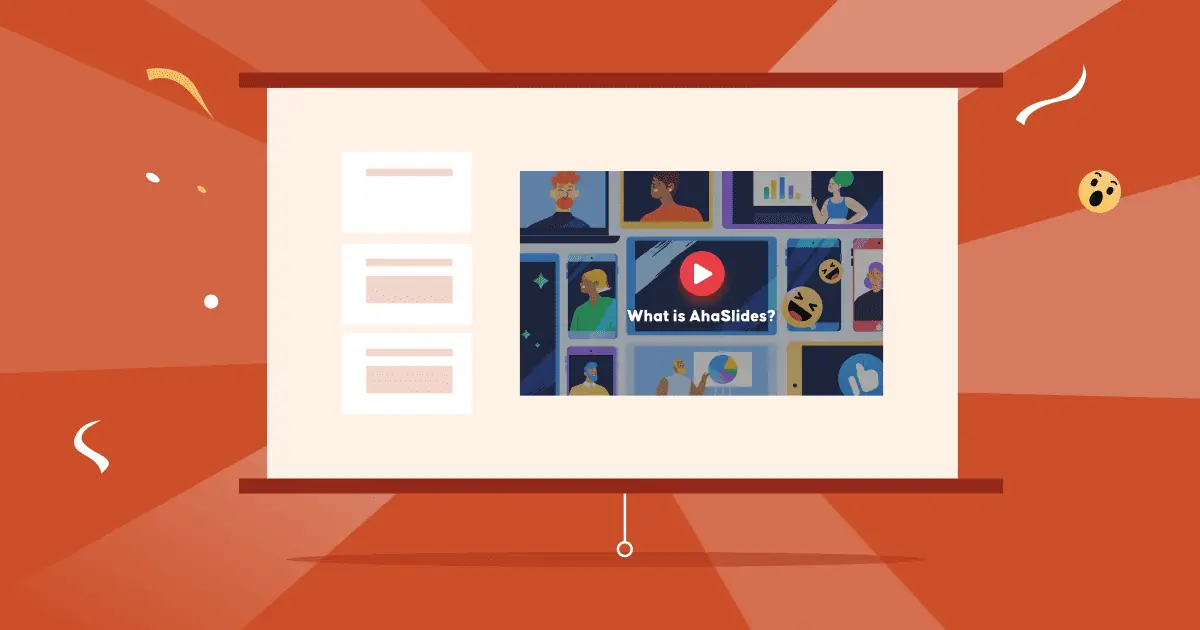Hvordan debatterer man for begyndere? At skændes er et stort, stort emne. Hvis du aldrig har skændtes før, kan det være overvældende at tænke på, hvad der vil ske, og hvordan du kan undgå at virke fuldstændig uvidende foran alle.
Der er meget at lære, før du kan finde modet til at stå på talerstolen. Men bare rolig; denne guide til debat for begyndere vil give dig de trin, tips og eksempler, du har brug for til at klare din næste debat. Så lad os tjekke disse dejlige debattips ud!
Indholdsfortegnelse
- 7 trin til at oprette en debat for begyndere
- 10 tips til nye debattører
- 6 debatstile
- 2 Eksempler på debat
- Flere tips med AhaSlides
Flere tips med AhaSlides

Start på få sekunder.
Få gratis skabeloner til studenterdebatter. Tilmeld dig gratis, og tag hvad du vil have fra skabelonbiblioteket!
🚀 Få gratis skabeloner ☁️
Sådan fungerer en debat for begyndere (i 7 trin)
Før du går i gang med at formulere dine argumenter som en professionel, skal du vide, hvordan en debat for begyndere fungerer. Tjek disse 7 trin til en debat for nybegyndere, og hvad du skal gøre undervejs, så vil du fuldt ud forstå, hvordan du bliver en bedre debattør!
1. Formålet er besluttet

Da vi kan bruge debatter mange steder og i mange situationer, f.eks. på skoler, i virksomhedsmøder, paneldiskussioner eller i politiske organer, er det afgørende, at de primære formål med debatten vælges først. Dette kan give et klart overblik over planlægningen og organisering af debatterne, fordi der er mange detaljer at arbejde med senere, som alle skal stemme overens.
Så før alt andet vil facilitatoren besvare dette – hvad er målene med denne debat?
Hvis du for eksempel er i en studenterdebat, bør målene være de samme som i din lektion, hvilket kan være at fremme elevernes kritiske tænkning og evner til at tale offentligt. Hvis det er på spil, kan det være at beslutte, hvilken af to idéer man skal følge.
2. Strukturen er valgt
Når man skal spørge, hvordan man debatterer godt, skal man have en struktur. Der findes mange variationer af debatstrukturer og flere formater inden for dem. Det er vigtigt, at du kender nogle grundlæggende termer, der bruges i mange almindelige typer debatter, før du forbereder dig til en debat...
- Emne – Enhver debat har et emne, som formelt kaldes et bevægelse or resolutionEmnet kan være en erklæring, en politik eller en idé, det afhænger af rammerne og formålet med debatten.
- to hold - Bekræftende (støtter forslaget) og Negativ (modsætter sig forslaget). I mange tilfælde består hvert hold af tre medlemmer.
- Dommere or Bedømmere: De mennesker, der bedømmer kvaliteten af argumenterne i debattørernes beviser og præstationer.
- timekeeper – Personen, der holder styr på tiden og stopper holdene, når tiden er gået.
- Observatører – Der kan være observatører (et publikum) i debatten, men de har ikke lov til at deltage.
Til en begynderdebat, efter at have modtaget forslaget, vil holdene have tid til at forberede sig. Det Bekræftende hold starter debatten med deres første taler, efterfulgt af den første taler fra Negativ hold. Så går den til den anden højttaler i Bekræftende hold, tilbage til den anden taler i Negativ hold og så videre.
Hver taler vil tale og fremlægge deres pointer inden for den fastsatte tid, der er angivet i debatreglerne. Husk at ikke alle debatter afsluttes med team Negativ; nogle gange, hold Bekræftende vil blive bedt om at afslutte.
Da du sikkert er nybegynder, kan du finde debatprocessen for begyndere jf. nedenståendeDen er let at følge og kan bruges i mange forskellige typer debatter.
3. Debatplanen er lavet
For at debatten kan forløbe gnidningsløst, vil facilitatoren have en plan, der er så detaljeret som muligtDe bør fortælle dig om denne plan, da det vil hjælpe med at visualisere alt og forhindre dig i at komme på afveje, hvilket er super nemt at gøre, når man deltager i en begynderdebat.
Her er en simpel tjekliste over, hvad en plan bør indeholde:
- Formålet med debatten
- Strukturen
- Hvordan rummet vil blive indrettet
- Tidslinjen og timingen for hver periode
- Formelle debatregler og instrukser for talerne og bedømmerne
- Skabeloner til notetagning for rollerne
- Resuméet for at afslutte debatten, når den slutter
4. Rummet er indrettet
Miljøet er afgørende for en debat, da det kan påvirke talerens præstation i en vis grad.
Din debat bør have en så professionel atmosfære som muligt. Der er mange måder at indrette et debatrum på, men uanset hvilken opsætning der vælges, vil det hele være centreret omkring 'talerområdet' i midten. Det er her, al debatmagien vil ske.
Hver højttaler, der repræsenterer de to hold, vil stå i højttalerområdet under deres tur og vende tilbage til deres plads, når de er færdige.
Nedenfor er en populært layout eksempel til en begynderdebat:
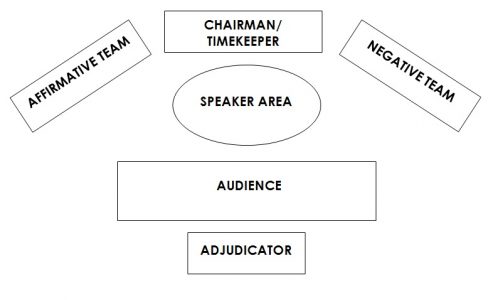
Der er selvfølgelig altid mulighed for at afholde en debat online. Du kan have svært ved at opleve den samme atmosfære som i en online begynderdebat, men der er nogle måder at krydre det på:
- Baggrundstilpasning: Hver rolle kan have en anden Zoom-baggrund: værten, tidtageren, dommerne og hvert hold. Dette kan være med til at differentiere hver enkelt deltagers roller og inspirere til en vis stolthed over den rolle, der gives.
- Understøttende enheder:
- Timer: Timing er vigtig i en debat, især for nybegyndere på deres første timeout. Din facilitator kan beslutte at holde styr på dit tempo med en timer på skærmen (selvom i de fleste debatter signalerer tidtageren bare, når der er 1 minut eller 30 sekunder tilbage).
- Lydeffekter: Husk, dette er kun en debat for begyndere. Du kan forvente, at din facilitator letter atmosfæren med opmuntrende klappende lydeffekter når en taler afslutter sin tale.
5. Holdene udvælges
Holdene vil blive opdelt i Bekræftende og Negativ. Normalt er holdene og talerpositionerne inden for disse hold randomiserede, så din facilitator kan bruge en spinnerhjul at gøre processen mere spændende og engagerende.
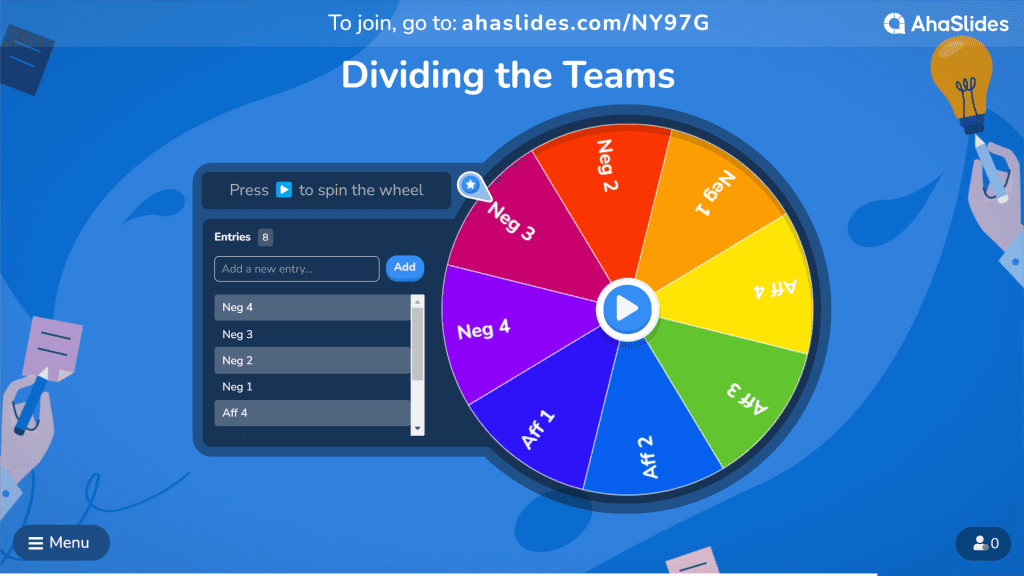
Når de to hold er blevet valgt, vil forslaget blive annonceret, og du vil få lidt tid til at forberede dig, ideelt set en time.
I denne tid vil facilitatoren pege på mange forskellige ressourcer, så teams kan forstå konteksten og problemerne for at fremsætte stærkere pointer. Jo mere du ved, jo mere energisk bliver debatten.
6. Debatten starter
Hver anden type debat kræver et andet format, og der kan være mange variationer. Nedenfor er en meget populær version, som kan bruges i enhver debat for begyndere.
Hvert hold har fire talerom i denne debat, så det er bedst at have 6 eller 8 talere. I tilfælde af 6 talere vil to debattører tale to gange.
| Tale | Tid | Debattørernes ansvar |
| 1. Bekræftende Konstruktiv | 8 min | Introducer bevægelsen og deres synspunkt Giv deres definitioner af nøglebegreber Fremfør deres argumenter til støtte for forslaget |
| 1. negativ konstruktiv | 8 min | Angiv deres argumenter for at modsætte sig forslaget |
| 2. Bekræftende Konstruktiv | 8 min | Fremlæg yderligere argumenter til støtte for forslaget og holdets meninger Identificer konfliktområder Besvar spørgsmål fra den negative taler (hvis nogen) |
| 2. Negativ Konstruktiv | 8 min | Fremsæt yderligere argumenter imod forslaget og styrk teamets holdninger Identificer konfliktområder Besvar spørgsmål fra den bekræftende taler (hvis nogen) |
| 1. negativ modbevisning | 4 min | Forsvar Negativ holdets argumenter og afvise de understøttende argumenter uden at tilføje nye argumenter eller information |
| 1. bekræftende gendrivelse | 4 min | Forsvar Bekræftende holdets argumenter og afvise de modsatte argumenter uden at tilføje nye argumenter eller information |
| 2. Negativ Afvisning (Afsluttende erklæring) | 4 min | Har en anden afvisning og afsluttende udtalelser |
| 2. bekræftende gendrivelse (Afsluttende erklæring) | 4 min | Har en anden afvisning og afsluttende udtalelser |
💡 Der kan være kort tid til at forberede sig før afvisningerne, afhængig af reglerne.
Du kan se et videoeksempel på dette format Her nede.
7. Døm Debatten
Det er tid til, at dommerne arbejder. De skal observere debatterne og hver enkelt debattørs præstation og derefter vurdere. Dette er nogle af de ting, de vil se på i din præstation…
- Organisation og overskuelighed – Strukturen bag din tale – giver det mening at formulere den, som du gjorde?
- Indhold – Disse argumenter, beviser, krydsforhør og gendrivelser, du fremlægger.
- Leverings- og præsentationsstil – Hvordan du fremfører dine pointer, herunder mundtligt og kropssprog, blik og tonefald.
10 tips til nye debattører
Ingen kan mestre alt fra starten, og hvis du aldrig har debatteret i dit liv, er det ikke nemt at komme i gang. Nedenfor er 10 hurtige råd at finde ud af, hvordan man debatterer effektivt og kan følge nybegyndere i enhver debat.
#1 - Forberedelse er nøglen – Undersøg emnet en masse på forhånd for at få ikke bare baggrundsinformation, men også selvtillid. Dette kan hjælpe uerfarne debattører med at forstå problemerne bedre for at være gode modbegyndere, derefter udarbejde deres argumenter, finde beviser og undgå at gå ned i kaninhuller. Enhver debattør bør skitsere alt i punkter (ideelt set 3 point for 3 argumenter) for bedre at arrangere ideer og se det 'store billede' af deres tale.
#2 - Hold alt ved emnet – En af debattens synder er at komme af sporet, da det spilder værdifuld taletid og svækker argumentet. Vær opmærksom på dispositionerne og hovedpointerne for at sikre, at de følger emnet og adresserer de rigtige problemer.
#3 - Kom med dine pointer med eksempler – At have eksempler gør dine debatsætninger mere overbevisende, og folk ser også tingene tydeligere, som f.eks. denne eksempel nedenfor…
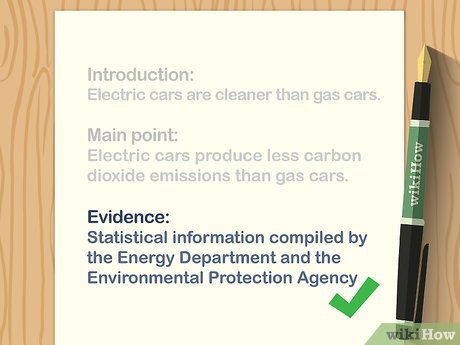
#4 - Prøv at tænke som modstanderne – Mens du reviderer idéer, så tænk på pointer, som modstanderen kan fremføre. Identificér et par stykker, og skriv et mindmap over gendrivelser, som du kunne tilbyde, hvis de do ende med at gøre disse pointer.
#5 - Hav en stærk konklusion – Afslut debatten med et par gode sætninger, der i det mindste kan opsummere hovedpointerne. I mange tilfælde kan debattører lide at afslutte med kraft, med én poetisk udformet sætning, der får det til at ske. mikrofondråbe øjeblik (se et eksempel på dette nedenfor).
#6 - Vær selvsikker (eller falsk det, indtil du klarer det!) – En af de vigtigste ting for at blive bedre til at debattere er stemningen. Debattører skal være sikre på, hvad de siger, da selvtillid har stor indflydelse på dommere og observatører. Jo mere du forbereder dig, jo mere selvsikker er du selvfølgelig.
#7 - Tal langsomt – Et meget almindeligt problem for nybegyndere i debatten er deres talehastighed. Oftest går det alt for hurtigt i første runde, hvilket forårsager ængstelse hos både lyttere og taleren. Tag en indånding og tal langsomt. Du får måske mindre ud af det, men det, du producerer, vil have tyngde.
#8 - Brug din krop og dit ansigt – Kropssprog kan understøtte dine pointer og vise selvtillid. Se modstanderne i øjnene, hav en pæn stående kropsholdning og kontroller ansigtsudtrykkene (bliv ikke for aggressiv) for at fange opmærksomheden.
#9 - Lyt godt efter og tag noter – Debattører skal være opmærksomme på hver tale og idé for at følge tempoet, støtte deres holdkammerater og bedre kunne imødegå modstandernes. Det kan være en stor hjælp at have noter, da ingen kan huske hvert eneste punkt for at imødegå eller uddybe. Husk kun at notere hovedpunkterne.
#10 - Undgå billige billeder – Fokuser på og modbevis dine modstanderes argumenter, ikke modstandernes selv. Ingen debattører bør være stødende over for andre; det viser mangel på professionalisme, og du vil helt sikkert blive kritiseret for det.
6 stilarter af begynderdebatter
Der er mange stilarter af debatter med forskellige formater og regler. At kende nogle af dem grundigt kan hjælpe begynderdebattører med at se processen, og hvad de skal gøre. Her er nogle almindelige debatstile, du måske ser i din første debat!
1. Politisk debat – Dette er en almindelig type, der kræver en del research. Debatten drejer sig om, hvorvidt man skal vedtage en bestemt politik eller ej, og det typisk i form af et team på to personer mere. Politisk debat bruges i mange skoler, fordi det er praktisk, og reglerne er lettere at følge end andre typer.
2. Folketingsdebat – Denne debatstil er baseret på den britiske regeringsmodel og debatterne i det britiske parlament. Den blev først taget i brug af britiske universiteter, men er nu den officielle debatstil i mange store debatkonkurrencer som World University Debating Championship og European Universities Debating Championship. Sådanne debatter er vittige og kortere end de traditionelle. politik debat, hvilket gør det velegnet til mange tilfælde, fra mellemskoler til universiteter.
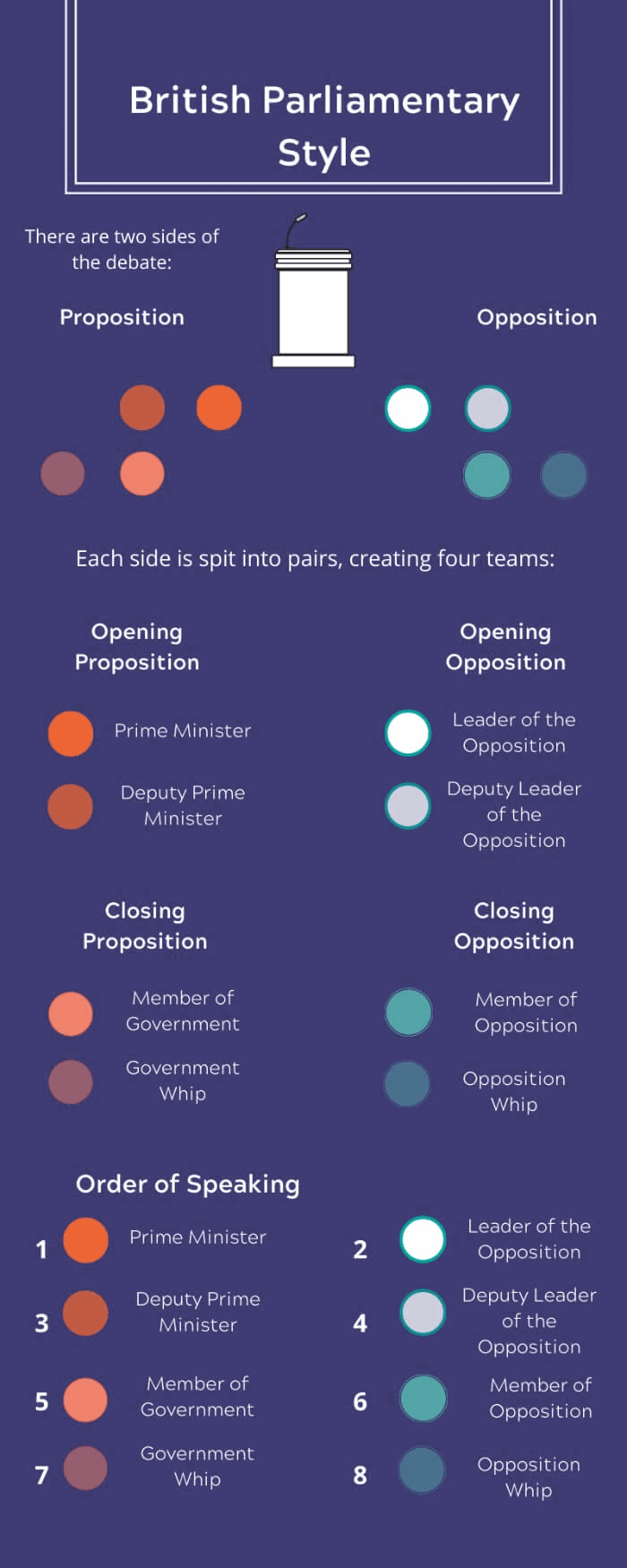
3. Offentlig forumdebat – I denne stil debatterer to hold nogle 'varme' og kontroversielle emner eller aktuelle problemstillinger. Disse emner har du sandsynligvis allerede en mening om, så denne type debat er mere tilgængelig end en politik debat.
4. Lincoln Douglas debat– Dette er en åben, en-til-en debatstil, opkaldt efter en berømt række debatter tilbage i 1858 mellem de amerikanske senatskandidater Abraham Lincoln og Stephen Douglas. I denne stil fokuserer debattørerne på mere dybsindige eller filosofiske spørgsmål, primært om væsentlige emner.
5. Spontan argument – To debattører diskuterer et bestemt emne; de skal formulere deres argumenter på meget kort tid og hurtigt reagere på deres modstanderes ideer uden megen forberedelse. Det kræver stærke argumentationsevner og kan hjælpe med at øge selvtilliden og overvinde sceneskræk.
6. Congressional debat – Denne stil er en simulering af den amerikanske lovgivende forsamling, hvor debattørerne efterligner kongresmedlemmer. De debatterer lovforslag, herunder lovforslag (lovforslag) og resolutioner (positionserklæringer). Den simulerede Kongres stemmer derefter for at vedtage lovgivningen og fortsætter med at stemme for eller imod den.
2 Eksempler på debat
Her har vi to eksempler på debatter, så du bedre kan se, hvordan de foregår…
1. Britisk parlamentsdebat
Dette er et kort klip fra en debat mellem den tidligere britiske premierminister Theresa May og den tidligere leder af Labourpartiet, Jeremy Corbyn. Debattens dynamiske atmosfære og ophedede diskussioner er typiske for denne form for højlydt debat. May afsluttede også sin tale med en så stærk udtalelse, at hun endda gik viralt!
2. Debattørerne
Elevdebatter bliver et stadig mere populært fænomen i skolen; nogle veludførte debatter kan endda være lige så engagerende som debatter fra voksne. Denne video er en episode fra et engelsksproget vietnamesisk debatprogram – The Debaters. Disse gymnasieelever debatterede forslaget 'Vi bifalder Greta Thunberg' i et ret almindeligt 3 mod 3-format.





